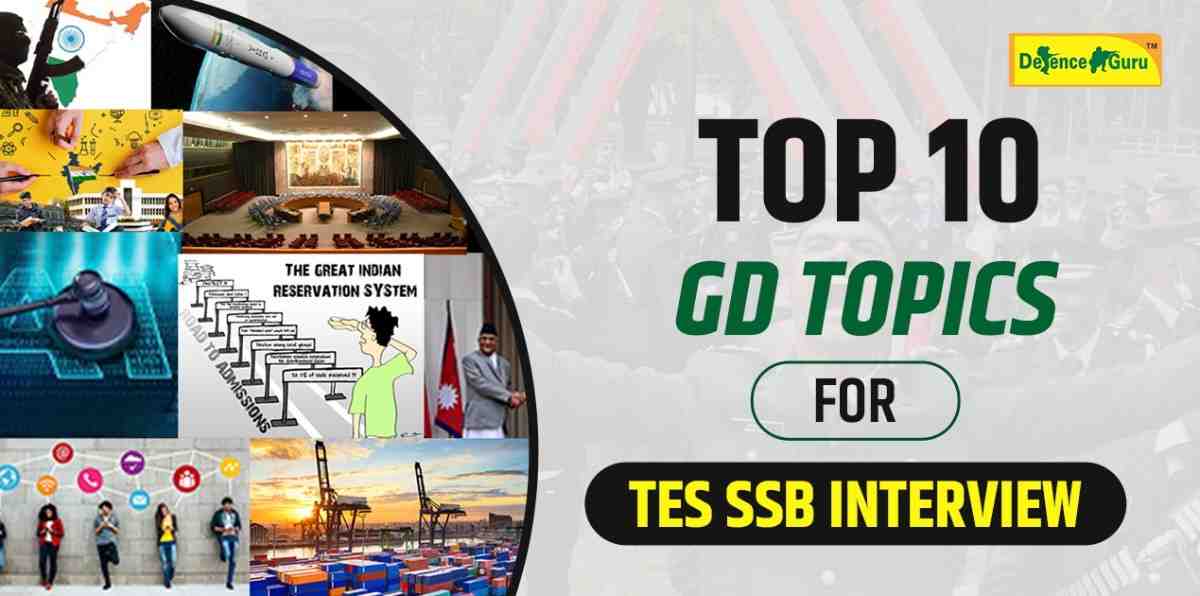Group Discussion is considered to be one of the most important tests of GTO conducted as a part of indoor tests. In this test, candidates sit in a semi-circle manner and 3 leads are provided for each topic of the group discussion. Candidates have to discuss all three leads. This is a crucial discussion because, in this test candidates’ knowledge, their thought process, and their ability to influence the group is evaluated. In this test, Candidates will be under the direct watch of GTO who will assess them. Here, you will be evaluated not just on your individual performance but also on the basis of your group performance. So, understanding the cruciality of this test, it will be unwise to take group discussion lightly. Here, we providing detailed content on Top Ten Group Discussion Topics for SSB Interview for the upcoming SSB. So, if you are going for your SSB, you must go through this document.
|
Top 10 Group Discussion Topics for SSB Interview |
|
Advantages and Disadvantages of Drone Technology
Drone technology, often referred to as Unmanned Aerial Vehicles (UAVs), has revolutionized various fields, offering unparalleled aerial access and versatility. However, it presents a nuanced picture, encompassing both immense potential and significant challenges that demand careful consideration.
Advantages
Enhanced Surveillance and Reconnaissance
Drones provide real-time aerial views at a fraction of the cost of traditional methods like manned aircraft. Their maneuverability makes them ideal for border patrol, disaster response, search and rescue operations, and monitoring sensitive areas.
Precision Agriculture and Environmental Monitoring
Drones equipped with multispectral sensors can map fields, analyze soil health, and optimize crop yields. They can also monitor air quality, track wildlife populations, and assess environmental damage.
Improved Logistics and Delivery
Drones offer the potential for swift, efficient delivery of goods, particularly in remote areas or challenging terrains. This could revolutionize healthcare, emergency services, and e-commerce.
Enhanced Infrastructure Inspection and Maintenance
Drones can safely access and inspect critical infrastructure like bridges, dams, and wind turbines, reducing costs and risks associated with traditional methods.
Disadvantages
Privacy Concerns and Misuse
Drones equipped with cameras and other sensors raise privacy concerns, particularly in densely populated areas. Potential misuse in surveillance or data collection necessitates robust regulations and ethical frameworks.
Safety and Security Risks
Uncontrolled drone flights pose risks to air traffic safety and national security. Concerns regarding cyberattacks and weaponization of drones warrant stricter regulations and technological safeguards.
Job Displacement and Economic Disruption
Automation through drones in certain sectors may lead to job displacement, requiring targeted workforce training and social safety nets. Environmental Impact: Noise pollution from drone flights and potential hazards to wildlife populations demand responsible use and technological advancements to minimize environmental impact.
Drone technology represents a powerful tool with far-reaching implications. By acknowledging both its advantages and disadvantages, and actively shaping its development and implementation, we can ensure drones contribute to a safer, more efficient, and sustainable future. |
|
Terrorism in India
Terrorism in India manifests as a hydra-headed monster, constantly shifting forms and adapting to countermeasures. Comprehending its multifaceted nature requires an in-depth analysis of its causes, manifestations, and strategic responses.
Causes
Socio-economic Discontent
Poverty, inequality, lack of opportunity, and perceived injustice can nurture feelings of alienation and desperation, driving recruitment for militant groups.
Ideological Extremism
Religious, ethnic, or political ideologies advocating violence create a sense of "us vs. them," fueling militant activities and justifying attacks on the "other."
Cross-border Infiltration
Porous borders, historical tensions with neighboring countries, and state sponsorship of militant groups pose significant security challenges.
Internal Vulnerabilities
Weak governance, poor infrastructure, and corruption in certain regions create fertile ground for terrorist activity and impede effective countermeasures.
Different Forms of Terrorism
Conventional terrorism
Attacks on civilian targets like markets, transportation hubs, and religious sites to cause mass casualties and sow fear.
Insurgency
Protracted armed conflict in regions like Jammu and Kashmir demanding secession or greater autonomy.
Cyberterrorism
Disruption of critical infrastructure, financial systems, and communication networks through cyberattacks.
Clandestine Activities
Espionage, financial networks, and fundraising tactics for supporting terrorist operations.
How to deal with Terrorism?
Combining security measures with socio-economic development initiatives to address root causes and foster inclusivity.
Intelligence Gathering and Sharing
Robust intelligence networks, inter-agency cooperation, and international collaboration are crucial for proactive threat detection and prevention.
Strengthening Border Security
Enhanced physical and technological surveillance, coupled with diplomatic efforts to address cross-border infiltration.
Countering Radicalization
Promoting tolerance, understanding, and critical thinking to combat extremist ideologies and prevent recruitment.
Legal and Judicial Framework
Effective legislation, fair trials, and timely justice are essential for deterrence and ensuring the rule of law.
India's fight against terrorism demands constant adaptation and innovation. Continuous assessment of threats, evolving strategies, and strengthening internal security while addressing societal imbalances are key to tackling this complex challenge. Only through a comprehensive and dynamic approach can India counter the hydra of terrorism and ensure the safety and security of its citizens. |
|
India in Space Research
India's journey in space research is a testament to its unwavering ambition and scientific pursuit. From humble beginnings under Dr. Vikram Sarabhai in the 1960s, India has ascended to become a major player in the global space arena, boasting:
A Robust Launch Vehicle Landscape
Polar Satellite Launch Vehicle (PSLV)
India's workhorse, with over 50 successful launches, capable of carrying multiple satellites into various orbits.
Geosynchronous Satellite Launch Vehicle (GSLV)
Higher payload capacity for heavier satellites used for communication and Earth observation.
GSLV Mark III
Next-generation workhorse, carrying large communication satellites and human capsules.
Significant Achievements in Satellite Technology
Remote Sensing Satellites
IRS series providing valuable data for agricultural monitoring, disaster management, and natural resource mapping.
Communication Satellites
INSAT and GSAT series serve vital needs in telecommunications, television broadcasting, and rural connectivity.
Navigation Satellites
NAVIC system offers an independent alternative to GPS for positioning and timing needs. Pioneering Scientific Missions:
Chandrayaan-1 and 2
Lunar missions mapping the lunar surface and searching for water ice, demonstrating India's lunar exploration capabilities.
Mangalyaan-1
India's first Mars mission, successfully entering Martian orbit and establishing India's footprint on the Red Planet.
Gaganyaan
Upcoming human spaceflight mission aiming to send three astronauts into space for a week-long orbit, marking a pivotal milestone in India's space program.
Challenges and the Road Ahead
Maintaining cost-effectiveness
Balancing ambition with budgetary constraints to ensure sustainable growth and accessibility.
Private sector participation
Fostering greater involvement of private companies to accelerate innovation and commercialization.
Technological advancements
Continuously upgrading launch vehicles, satellite technology, and scientific instruments to remain competitive in the global race. India's space journey reflects its commitment to scientific progress, national security, and economic development. By overcoming challenges and capitalizing on its strengths, India is poised to further solidify its position as a leading force in the global space landscape, opening doors to exciting frontiers of scientific discovery and technological advancement. |
|
Regulation of Artificial Intelligence
The rise of Artificial Intelligence (AI) presents a thrilling paradox – immense potential for progress interwoven with intricate ethical dilemmas and potential societal risks. Recognizing this, crafting a robust regulatory framework for AI has become a critical imperative, and India is actively navigating this complex landscape.
Challenges Demanding Regulation
Transparency and Explainability
Black-box algorithms can amplify biases and lead to discriminatory outcomes. Regulations should mandate transparency in data usage, model development, and decision-making processes to ensure fairness and accountability.
Privacy and Data Protection
AI relies heavily on data, raising concerns about data collection, storage, and potential misuse. Strong data protection laws and ethical frameworks are crucial to safeguard individual privacy and prevent discriminatory profiling.
Algorithmic Bias and Fairness
AI algorithms learn from biased data, potentially perpetuating social injustices. Regulations must address biased datasets and algorithmic bias to ensure fair and equitable outcomes for all.
Economic Disruption and Job Displacement
Automation through AI might displace certain jobs, necessitating reskilling initiatives and social safety nets for affected workers.
National Security and Weaponization
Weaponized AI poses existential threats. International collaboration and responsible development agreements are crucial to mitigating these risks.
India's Regulatory Steps
Draft AI Policy (2019)
Outlines principles of ethics, transparency, privacy, and accountability in AI development and deployment.
Personal Data Protection Bill (2019)
Aims to regulate data collection, usage, and storage, offering some protection from AI-driven data abuse.
Setting Up of AI Task Force
Established under the Ministry of IT to examine ethical issues and recommend regulatory frameworks. Focus on Sector-Specific Regulations: Exploring regulatory frameworks for specific sectors like healthcare, finance, and autonomous vehicles. |
|
New Education Policy and System in India
India's New Education Policy (NEP) 2020 marks a paradigm shift in the nation's approach to education, aiming to cultivate critical thinkers, lifelong learners, and responsible citizens. Let's delve into its key tenets:
Holistic and Integrated Learning
5+3+3+4 System
Replacing the rigid 10+2 structure, NEP introduces a flexible system, integrating preschool with formal education and emphasizing holistic development at all stages.
Foundational Literacy and Numeracy
Focus on mastering reading, writing, and basic math as building blocks for further learning.
Multidisciplinary Approach
Breaking down silos between disciplines, encouraging critical thinking, and integration of knowledge across domains.
Vocational Integration
Early introduction of vocational skills and internships, enhancing employability and bridging the skill gap.
Flexibility and Choice
Multiple Pathways: Students can choose diverse subjects and study tracks aligning with their interests and aptitudes.
Credit System
Enables flexibility in pursuing courses and transferring credits across institutions, promoting mobility and lifelong learning.
Multilingualism
Recognizing the value of mother tongue and local languages, NEP encourages multilingualism to promote inclusivity and cultural diversity. Technology Integration: Embracing technology as a tool for learning, enhancing access and personalized learning experiences. Focus on Critical Thinking and Skill Development:
Active Learning
Moving away from rote learning, NEP emphasizes inquiry-based learning, problem-solving, and collaborative approaches.
Teacher Training and Development
Continuous professional development programs for teachers to equip them with effective pedagogical skills and adapt to the new curriculum.
Developing robust systems for assessing student learning outcomes and ensuring quality standards across institutions is crucial. Providing equitable access to technology and bridging the digital divide in rural and remote areas remains a significant challenge. |
|
Reforms in the United Nations Security Council
The United Nations Security Council (UNSC), despite its crucial role in maintaining international peace and security, faces increasing calls for reform in the 21st century. Concerns regarding its composition, decision-making processes, and effectiveness have fueled debates about its ability to respond adequately to contemporary challenges.
Arguments for Reform
Undemocratic Representation
Five permanent members (P5) – US, Russia, China, UK, France – hold veto power, raising concerns about unequal representation and privileging the interests of a select few over the broader international community.
Lack of Regional Representation
Africa, the world's second-most populous continent, and Latin America have no permanent representation, highlighting geographical underrepresentation.
Outdated Cold War Structure
The P5 system reflects the power dynamics of a bygone era, failing to accommodate the rise of new global players like India, Brazil, and South Africa.
Proposed Reforms
Expansion of Permanent Membership
Granting permanent seats to emerging powers, with or without veto power, to reflect the shifting global landscape.
Increased Representation for Underrepresented Regions
Allocating additional permanent or non-permanent seats to Africa and Latin America.
Regulation of Veto Power
Limiting the use of vetoes in specific cases like humanitarian crises or genocide to prevent unilateral blockages.
Transparency and Accountability Measures
Making decision-making processes more transparent and establishing mechanisms for holding the Council accountable for its actions.
Challenges
Reaching Consensus
Achieving agreement on reform proposals among the P5 and the larger UN membership presents a significant challenge.
Maintaining the Council's Effectiveness
Balancing the need for reform with preserving the Council's ability to act decisively in times of crisis is crucial.
Addressing Power Dynamics
Navigating the complex power dynamics between established and emerging powers within the global political landscape is essential.
Reforming the UNSC remains a complex and contested endeavor. While achieving comprehensive reform may be elusive in the near future, ongoing dialogue, exploration of incremental changes, and commitment to a more inclusive and representative Council are crucial steps towards ensuring its relevance and effectiveness in the 21st century. |
|
Influence of Social Media on Youth
Social media has woven itself into the fabric of young lives, shaping communication, identity, and engagement with the world. Its influence, however, is a double-edged sword, offering immense potential alongside significant challenges. Let's delve into the complex interplay between social media and youth:
Positive Influences
Connectivity and Communication
Platforms provide unprecedented opportunities for connection and communication, bridging geographical and social barriers, fostering inclusivity, and enabling global engagement.
Information and Learning
Diverse content exposes youth to a wealth of information, news, and perspectives, stimulating curiosity, broadening knowledge, and promoting critical thinking.
Identity Formation and Self-Expression
Social media provide spaces for exploring and expressing individual identities, experimenting with self-presentation, and connecting with like-minded communities.
Social Awareness and Activism
Platforms can raise awareness about social issues, mobilize collective action, and empower youth to become agents of change. Skill Development and Creativity: Digital tools and platforms encourage creativity, communication skills, and technological literacy, potentially opening doors to career opportunities.
Negative Influences
Mental Health and Well-being
Social media can exacerbate anxieties, foster feelings of inadequacy and FOMO (fear of missing out), and contribute to depression and cyberbullying.
Misinformation and Fake News
The prevalence of inaccurate information and manipulative content can hinder critical thinking skills, exacerbate societal divisions, and fuel online conflicts.
Addiction and Compulsive Use
Excessive social media engagement can lead to addictive behaviors, displacing real-world interactions and impacting concentration and productivity.
Privacy Concerns and Cyberbullying
Sharing personal information online exposes youth to privacy risks and potential cyberbullying, impacting self-esteem and mental well-being.
Unrealistic Body Image and Social Comparison
Curated online personas and filtered images can distort body image perceptions, leading to insecurities and unhealthy comparisons. Navigating the Digital Landscape:
Digital Literacy and Critical Thinking
Equipping youth with the skills to discern fact from fiction, evaluate information sources, and practice responsible online behavior is crucial.
Promoting Mindfulness and Healthy Tech Use
Fostering healthy boundaries around screen time, encouraging real-world interactions, and prioritizing offline activities are essential for balanced social media use.
Fostering Positive Online Communities
Supporting constructive online interactions, celebrating diversity, and promoting empathy can create safe and empowering online environments.
Parental Guidance and Open Communication
Open communication between parents and youth about online experiences, concerns, and challenges is key to promoting responsible digital citizenship.
Policy and Regulatory Frameworks
Governments and platforms have a responsibility to address issues like cyberbullying, privacy violations, and harmful content through proactive policies and regulations.
Social media's influence on youth is undeniable, demanding a nuanced understanding of its potential benefits and risks. Cultivating critical thinking skills, prioritizing real-world connections, and fostering responsible online practices are key to ensuring that young people navigate the digital landscape safely and productively. By taking collective responsibility – individuals, educators, platforms, and policymakers – we can harness the power of social media to empower, educate, and connect the next generation, creating a more informed, engaged, and resilient future. |
|
Reservation System in India
India's reservation system, enshrined in the Constitution, remains a fiercely debated topic. Its purpose – to address historical injustices and promote social inclusion for historically disadvantaged communities – is often acknowledged, but its implementation and effectiveness raise complex questions. Let's delve into the intricate layers of this multifaceted system:
Constitutional Mandates
Articles 15(4) and 16(4)
Guarantee reservation in government jobs and educational institutions for Scheduled Castes (SCs), Scheduled Tribes (STs), and Other Backward Classes (OBCs).
Article 243D and 233T
Mandate reservation for SCs and STs in Panchayats and Municipalities, respectively.
Arguments for Reservation
Address Historical Discrimination
SCs, STs, and OBCs faced centuries of social and economic exclusion, and reservations aim to provide opportunities for upward mobility and bridge the gap with dominant communities.
Promote Social Justice and Inclusivity
Reservations ensure adequate representation of disadvantaged groups in public institutions, fostering a more equitable and representative society.
Combat Caste-Based Discrimination and Prejudice
Reservations challenge prevalent discriminatory practices in education and employment, offering avenues for empowerment and breaking systemic barriers.
Arguments against Reservation
Reverse Discrimination
Critics argue that reservations disadvantage individuals from non-reserved categories, leading to resentment and potential inefficiency in recruitment and admissions.
Creamy Layer
The inclusion of affluent individuals from reserved categories raises concerns about the system's effectiveness in targeting the genuinely disadvantaged.
Misuse and Corruption
Instances of manipulation and false claims to claim reserved benefits under the system raise questions about its integrity and fairness.
Focus on Representation over Merit
Concerns exist that reservation may compromise meritocratic principles and hinder the selection of the most qualified candidates.
India's reservation system is a complex, evolving mechanism grappling with the legacy of historical injustices and striving for a more equitable society. Engaging in nuanced discussions, acknowledging its merits and limitations, and exploring alternative strategies for social inclusion are crucial for navigating this intricate labyrinth. Finding a sustainable and equitable path forward hinges on continuous refinement, data-driven evaluation, and unwavering commitment to forging a just and inclusive future for all Indians. |
|
India-Nepal Relations
India and Nepal share a unique bond, intertwined by geography, history, culture, and deep human connections. However, this relationship, like the majestic Himalayas that bind them, is complex and multifaceted, demanding a nuanced understanding:
Foundations of the Relationship
Treaty of Peace and Friendship (1950)
Provides the bedrock of the relationship, guaranteeing mutual respect for territorial integrity and non-interference in internal affairs.
Open Border Policy
Facilitates the free movement of people and goods, fostering social and economic ties.
Gorkha Regiments
Nepalese soldiers in the Indian Army serve as a tangible symbol of shared military history and cultural affinity. Deep Cultural and Religious Links: Hinduism, Buddhism, and shared historical figures bind the two societies on a spiritual and cultural level.
Areas of Cooperation
Economic Interdependence
India is Nepal's largest trading partner and source of foreign investment, vital for Nepal's development.
Hydropower Development
Collaboration on hydropower projects in Nepal benefits both countries by generating electricity and addressing energy needs.
Regional Connectivity
Cooperation in regional initiatives like BIMSTEC strengthens economic collaboration and connectivity in the subcontinent.
Cultural Exchange
A vibrant exchange of artists, musicians, and scholars enriches both cultures and reinforces shared artistic and intellectual traditions.
Challenges and Tensions
Water Resource Issues
Dispute over water sharing from rivers originating in Nepal highlights the need for efficient water management agreements.
Political Instability in Nepal
Internal political dynamics in Nepal can sometimes cause diplomatic friction with India.
Trade Imbalance
Nepal's significant trade deficit with India raises concerns about fair trade practices and economic asymmetry.
Refugee Issue
The presence of Indian-origin refugees in Nepal can occasionally strain relations.
The India-Nepal relationship, much like the Himalayas, presents a landscape of opportunities and challenges. By navigating these complexities with mutual respect, open communication, and a commitment to shared prosperity, both nations can forge an even stronger, more vibrant partnership that transcends borders and transcends generations. |
|
New Foreign Trade Policy 2023
The New Foreign Trade Policy (FTP) 2023 marks a significant leap in India's quest to propel its exports, aiming to triple merchandise and services exports by 2030. Let's dissect its key features and analyze its potential impact:
Key Pillars of the Policy
Incentives and Remission
Enhanced duty remission schemes like RoDTEP and PLI aim to reduce export costs and boost competitiveness in key sectors like electronics, textiles, and engineering.
Export Promotion through Collaboration
Increased focus on collaboration between policymakers, exporters, states, and Indian missions abroad to navigate challenges and identify potential markets.
Ease of Doing Business
Streamlined procedures, reduced transaction costs, and simplified regulatory frameworks are designed to expedite export processes and attract foreign investment.
Emerging Areas
The policy recognizes the potential of e-commerce, district-level export hubs, and service exports, incentivizing participation and infrastructure development in these new frontiers.
Impacts and Opportunities
MSME Boost
Reduced minimum export requirements for status recognition and lower user charges under schemes like EPCG and Advance Authorisation are expected to significantly benefit MSMEs, facilitating their entry into the export arena.
E-commerce Boom
The policy supports e-commerce exports through increased consignment-wise caps and facilitation of cross-border payment settlements, paving the way for India's potential in this rapidly growing market.
Global Value Chains
Focus on PLI schemes in strategic sectors like electronics and automotives aims to attract foreign investment and integrate India into global value chains, boosting manufacturing and exports.
New Export Avenues
The policy highlights the potential of service exports in areas like IT, healthcare, and education, diversifying India's export basket and unlocking new economic opportunities.
Challenges
Implementation Efficiency
Effective implementation across diverse states and institutions is crucial to fully realize the policy's potential.
Infrastructure Development
Upgrading logistics infrastructure, including ports, airports, and digital connectivity, is key to enhancing export competitiveness.
Skills Development
Equipping the workforce with necessary skills, particularly in emerging sectors, is essential to cater to global market demands.
Trade Negotiations
Addressing trade barriers and negotiating favorable trade agreements in key markets will be crucial for sustained export growth.
The New Foreign Trade Policy 2023 charts a bold course for India's export ambitions. Its focus on incentives, collaboration, ease of doing business, and embracing new opportunities holds immense potential to propel India's export machinery. However, overcoming implementation challenges, investing in infrastructure and skills development, and navigating the international trade landscape will be crucial to transforming this policy into tangible economic growth and global competitiveness. |






















